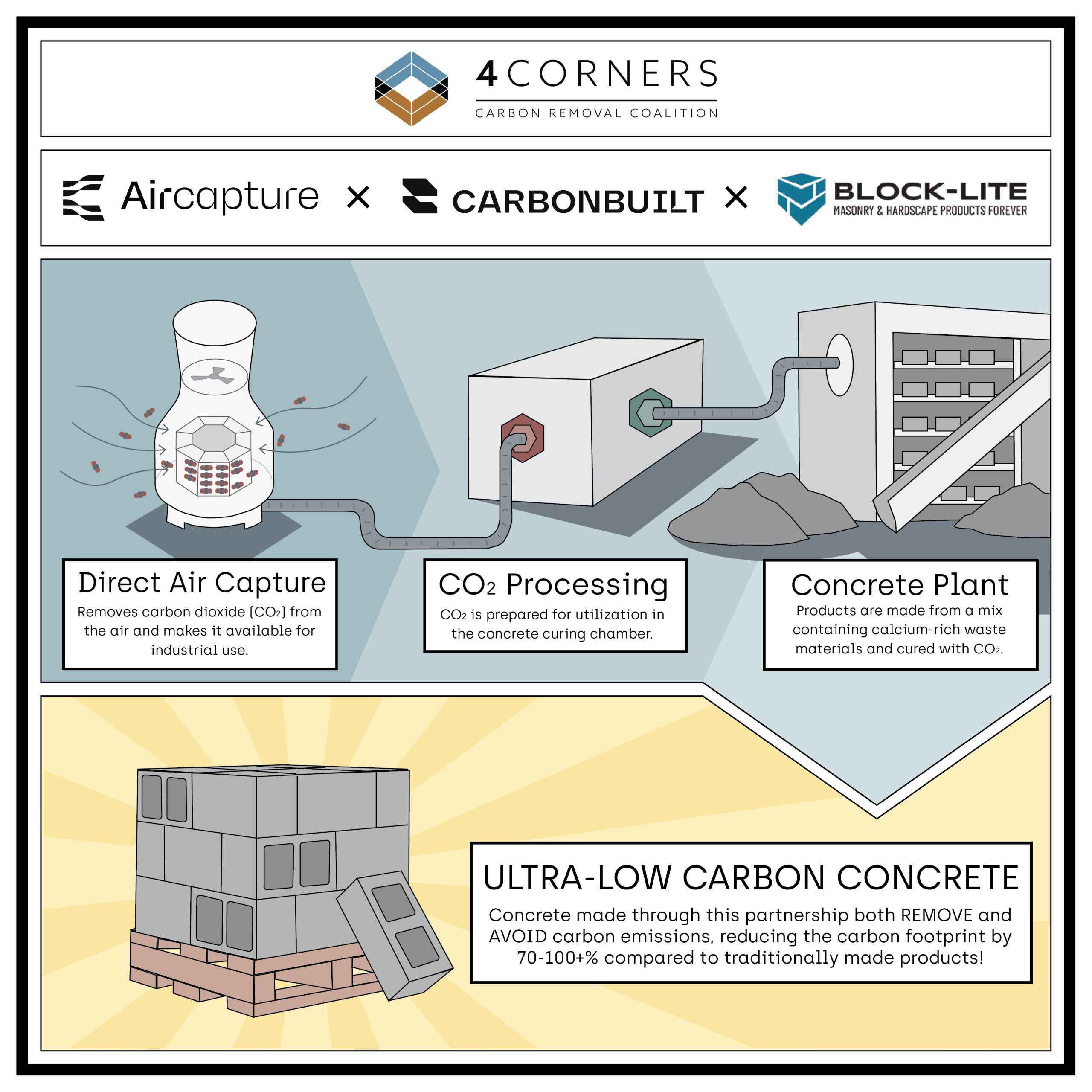
The 4 Corners Carbon Coalition has awarded $150,000 to Arizona concrete masonry producer Block-Lite, plus California partners CarbonBuilt of Los Angeles and Aircapture LLC of Berkeley, to develop the world’s first fully-integrated direct air capture (DAC)-to-concrete assembly. Based at the producer’s Flagstaff plant, the project has the potential to yield market rate block exhibiting 70 percent lower embodied carbon versus conventional concrete.
“All too often sustainable building materials require a tradeoff between cost and performance, but what is unique about this project is that there’s no ‘green premium’,” says Block-Lite CEO Ryan Ross. “We’re going to be able to produce on-spec, ultra-low carbon blocks at price parity with traditional block, which should speed adoption and impact.”
CarbonBuilt will install carbon dioxide-mineralizing equipment at the Flagstaff operation, tapping an array of modular Aircapture DAC devices engineered to isolate high purity CO2 from onsite air intake. The project will enable Block-Lite to avoid 2,000 to 3,000 metric tons of CO2 emissions and capture 500-plus metric tons of atmospheric CO2 annually.
“Large scale, durable carbon utilization can play a critical role in driving down the cost of DAC and accelerating atmospheric carbon removal. The concrete industry’s scale and global reach uniquely position it as an enabling partner to the DAC industry,” says CarbonBuilt CEO Rahul Shendure. “We intend for this project to become a blueprint that can be replicated at many of the thousands of concrete plants around the world. The grant from Four Corners is a key first step in the overall plan and we look forward to building on the momentum with our partners.”

underscored in late 2022 with deployment of roof-mounted solar arrays to power much of its blockmaking operation.
“Atmospheric carbon dioxide removal and carbon utilization into products is on the critical path to addressing climate change,” adds Aircapture CEO Matt Atwood. “While the common assumption of industrial carbon application is that of a short
A new ASTM International paper presents results of an NCMA Education and Research Foundation investigation quantifying the amount and rate that machine-molded concrete products absorb and permanently lock up atmospheric carbon dioxide. “Conceptual Test Protocols for Measuring Carbon Sequestration of Manufactured Dry-Cast Concrete Products” covers lab work undertaken to develop and refine procedures that deliver repeatable, accurate measurement of CO2 uptake in building or hardscape block or other similarly formulated and fabricated concrete elements.
While they continue to gauge long-term sequestration characteristics, investigators observed block specimens averaging 1.3 lbs./ft.3 (21 kg/m3) uptake at 28 days. That CO2 volume, “Conceptual Test Protocols” authors note, is “significantly higher than would have been predicted using wet-cast concrete carbonation data.” The thrust of the investigation, they add, centered on “the relatively porous nature of dry-cast concrete compared to wet-cast concrete, making it a potentially attractive candidate for carbon sequestration. While considerable research has been conducted on carbonation of wet-cast concrete, there has been limited research on quantifying carbon uptake in manufactured, dry-cast concrete products, including concrete masonry units.”
“Some investigations have focused on quantifying the potential shrinkage of concrete as it carbonated to mitigate cracking, whereas other studies have measured changes in pH levels within the concrete and the resulting effects on the corrosion of embedded ferrous metals,” authors explain. “Current market drivers, however, have shifted beyond the functional performance aspects of carbon sequestration of cement-based materials and are now placing much more emphasis on the embodied carbon, and potential carbon sequestration, of construction materials.”
Authoring “Conceptual Test Protocols” are Craig Walloch of ACM Chemistries, Norcross, Ga.; Donald Broton and Laura Powers of CTLGroup, Skokie, Ill.; and, Jason Thompson, formerly of the Concrete Masonry & Hardscapes Association. Their paper can be ordered through ASTM International, www.astm.org.
lived product, we are demonstrating a novel solution to create permanent carbon storage sinks in our built environment. This exemplary project couples industrial decarbonization together with cost savings, carbon removal, job creation and environmental co-benefits.”
RESEARCHERS RAISE DRY-CAST CONCRETE CO2 SEQUESTRATION RATE MODEL
A new ASTM International paper presents results of an NCMA Education and Research Foundation investigation quantifying the amount and rate that machine-molded concrete products absorb and permanently lock up atmospheric carbon dioxide. “Conceptual Test Protocols for Measuring Carbon Sequestration of Manufactured Dry-Cast Concrete Products” covers lab work undertaken to develop and refine procedures that deliver repeatable, accurate measurement of CO2 uptake in building or hardscape block or other similarly formulated and fabricated concrete elements.
While they continue to gauge long-term sequestration characteristics, investigators observed block specimens averaging 1.3 lbs./ft.3 (21 kg/m3) uptake at 28 days. That CO2 volume, “Conceptual Test Protocols” authors note, is “significantly higher than would have been predicted using wet-cast concrete carbonation data.” The thrust of the investigation, they add, centered on “the relatively porous nature of dry-cast concrete compared to wet-cast concrete, making it a potentially attractive candidate for carbon sequestration. While considerable research has been conducted on carbonation of wet-cast concrete, there has been limited research on quantifying carbon uptake in manufactured, dry-cast concrete products, including concrete masonry units.”
“Some investigations have focused on quantifying the potential shrinkage of concrete as it carbonated to mitigate cracking, whereas other studies have measured changes in pH levels within the concrete and the resulting effects on the corrosion of embedded ferrous metals,” authors explain. “Current market drivers, however, have shifted beyond the functional performance aspects of carbon sequestration of cement-based materials and are now placing much more emphasis on the embodied carbon, and potential carbon sequestration, of construction materials.”
Authoring “Conceptual Test Protocols” are Craig Walloch of ACM Chemistries, Norcross, Ga.; Donald Broton and Laura Powers of CTLGroup, Skokie, Ill.; and, Jason Thompson, formerly of the Concrete Masonry & Hardscapes Association. Their paper can be ordered through ASTM International, www.astm.org.